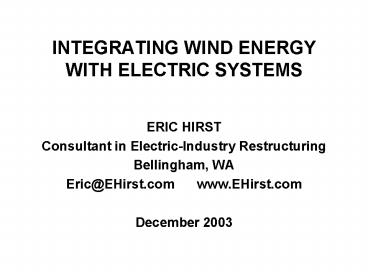INTEGRATING WIND ENERGY WITH ELECTRIC SYSTEMS - PowerPoint PPT Presentation
1 / 24
Title:
INTEGRATING WIND ENERGY WITH ELECTRIC SYSTEMS
Description:
Higher if wind is remotely located and/or connected to system on low-voltage lines ... Because wind is small, it imposes no costs on system ... – PowerPoint PPT presentation
Number of Views:56
Avg rating:3.0/5.0
Title: INTEGRATING WIND ENERGY WITH ELECTRIC SYSTEMS
1
INTEGRATING WIND ENERGY WITH ELECTRIC SYSTEMS
- ERIC HIRST
- Consultant in Electric-Industry Restructuring
- Bellingham, WA
- Eric_at_EHirst.com www.EHirst.com
- December 2003
2
PURPOSE OF PRESENTATION
- Provide background and structure for workshop
- Long-term issues
- Transmission planning and pricing
- Resource adequacy (capacity credit)
- Operations (and spot markets)
- Day-ahead unit commitment
- Real-time dispatch
- Intrahour balancing
- Load following
- Regulation
- Summarize key findings from three projects
- MN wind farm with PJM system
- PNW wind farms with BPA system
- Simulations of large wind farms with SPS system
3
SCHEMATIC OF WINDCOSTS AND REVENUES
4
WIND HAS UNUSUAL ENERGY AND LOCATIONAL
CHARACTERISTICS
- ENERGY
- Limited control
- Relatively unpredictable
- Variable
- Affect balancing costs and ability to sell
energy in forward markets
- TRANSMISSION
- Access (recovery of fixed costs)
- Congestion
- Losses
- Remote locations increase transmission costs for
low-capacity-factor wind
5
ELECTRICAL SYSTEMS HAS UNIQUE CHARACTERISTIC
- Because electricity cannot be economically
stored, generation and load must be balanced in
real time - Balancing requirement (NERCs CPS 1 and 2)
interacts with unique characteristics of wind
6
LONG-TERM PLANNING
7
TRANSMISSION CAN BE EXPENSIVE FOR
LOW-CAPACITY-FACTOR WIND
Wind pays 4 to 9/MWh for firm
transmission, with 33 capacity factor
8
OTHER TRANSMISSION CHARGES
- Losses
- Higher if wind is remotely located and/or
connected to system on low-voltage lines - Average vs. marginal losses
- Congestion
- Locational marginal prices
- OR
- Transmission loading relief
9
SHOULD WIND RECEIVECAPACITY CREDIT?
- Threshold issue Can energy markets alone provide
sufficient capacity - Critical role of dynamic pricing
- Must qualifying capacity be
- Dispatchable (probably not, e.g., nuclear power)
- Have high availability factor
- Would higher accuracy of day-ahead wind forecast
models increase amount of qualifying capacity - Traditional capacity-expansion models value wind
- based on LOLP at about capacity factor (e.g.,
35)
?
10
SHORT-TERM OPERATIONS
11
SEVERAL COSTS AND REVENUES FROM DAY-AHEAD TO
REAL-TIME
12
ENERGY PRICES CAN BE VOLATILE
13
SPOT PRICES AFFECT WIND PAYMENTS
- Day-ahead prices are much less volatile than
real-time prices - On average (e.g., monthly), day-ahead and
real-time prices should converge - Hourly regulation prices also quite volatile
- Accurate forecasts of wind output reduce
volatility (risks) of energy payments
14
LAKE BENTON WIND FARM IN SW MINNESOTA IS TYPICAL
- 138 turbines, capacity 103.5 MW
- 35 capacity factor from 7/2000 through 6/2001
- Monthly average output varied widely
- 18 MW in 7/2000
- 48 MW in 4/2001
- Hourly output completely uncorrelated with either
NSP (Xcel Energy) or PJM load
15
LB MONTHLY OUTPUT VARIABLE
16
DAILY OUTPUT MORE VARIABLE
17
HOURLY OUTPUT MUCH MORE VARIABLE
18
PJM SUMMER LOAD AND PRICE HIGHLY CORRELATED, r
0.88
Sun
19
PJM SYSTEM LOAD STABLEFROM DAY TO DAY
5 weekdays in August 2000
20
WIND OUTPUT VARIESFROM DAY TO DAY
Same 5 weekdays in August 2000
21
GEOGRAPHICAL DISPERSIONREDUCES WIND
VARIABILITYAND FORECAST ERROR
30 lower
Five sites, 200 miles end to end
22
DA AND RT HOURLY PAYMENTS DECLINE WITH WIND
CAPACITY
23
REGULATION COSTS 0.1 - 3/MWh, LOAD FOLLOWING
ZERO
24
LESSONS LEARNED FROM 3 STUDIES
- Feasible and practical to calculate costs and
revenues for wind farm - Advocacy positions incorrect
- Because wind is small, it imposes no costs on
system - Because wind is volatile, system must offset
every MW movement - Scheduling wind ahead of time increases revenues
- Analyze wind as part of total system
- Incorrect to analyze wind in isolation
- Results depend strongly on hourly prices, perhaps
more than on wind output - Market design matters - avoid arbitrary penalties
- Much more work must be done to quantify and
monetize the situation































